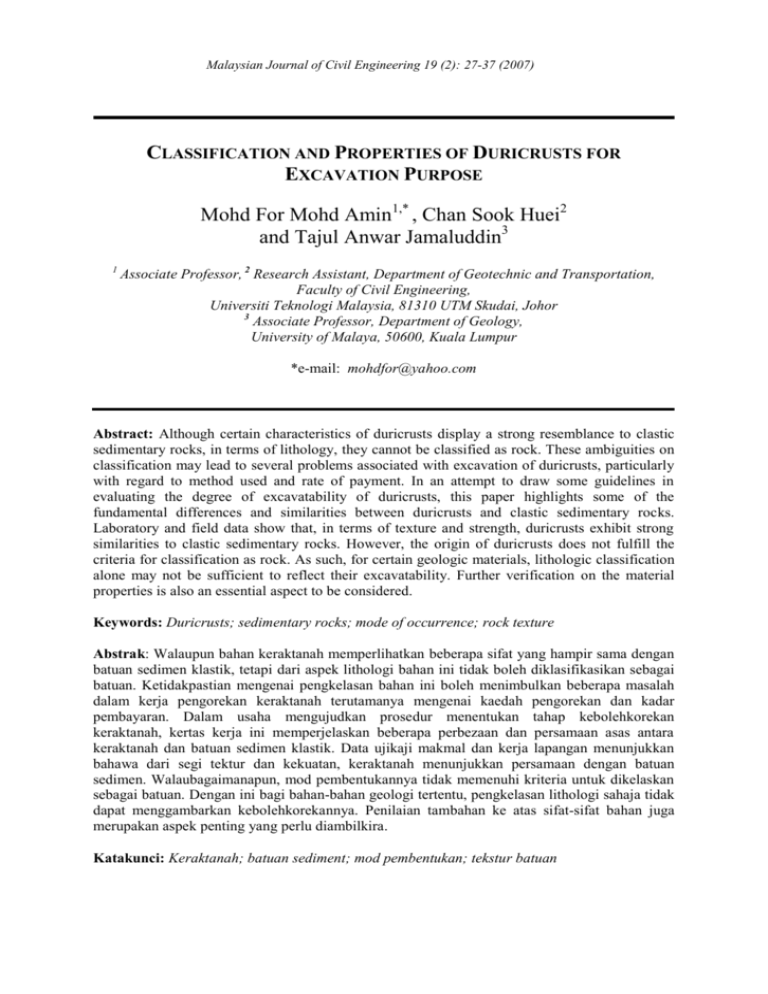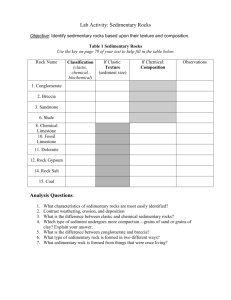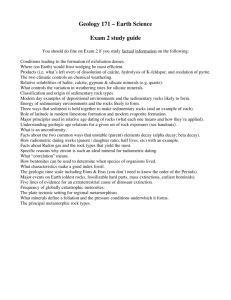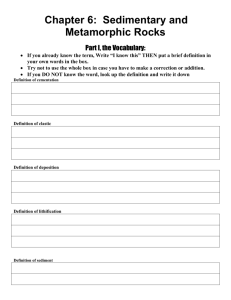Reinforcement mechanisms of rock bolt – a laboratory investigation
advertisement

Malaysian Journal of Civil Engineering 19 (2): 27-37 (2007) CLASSIFICATION AND PROPERTIES OF DURICRUSTS FOR EXCAVATION PURPOSE Mohd For Mohd Amin1,* , Chan Sook Huei2 and Tajul Anwar Jamaluddin3 1 Associate Professor, 2 Research Assistant, Department of Geotechnic and Transportation, Faculty of Civil Engineering, Universiti Teknologi Malaysia, 81310 UTM Skudai, Johor 3 Associate Professor, Department of Geology, University of Malaya, 50600, Kuala Lumpur *e-mail: mohdfor@yahoo.com Abstract: Although certain characteristics of duricrusts display a strong resemblance to clastic sedimentary rocks, in terms of lithology, they cannot be classified as rock. These ambiguities on classification may lead to several problems associated with excavation of duricrusts, particularly with regard to method used and rate of payment. In an attempt to draw some guidelines in evaluating the degree of excavatability of duricrusts, this paper highlights some of the fundamental differences and similarities between duricrusts and clastic sedimentary rocks. Laboratory and field data show that, in terms of texture and strength, duricrusts exhibit strong similarities to clastic sedimentary rocks. However, the origin of duricrusts does not fulfill the criteria for classification as rock. As such, for certain geologic materials, lithologic classification alone may not be sufficient to reflect their excavatability. Further verification on the material properties is also an essential aspect to be considered. Keywords: Duricrusts; sedimentary rocks; mode of occurrence; rock texture Abstrak: Walaupun bahan keraktanah memperlihatkan beberapa sifat yang hampir sama dengan batuan sedimen klastik, tetapi dari aspek lithologi bahan ini tidak boleh diklasifikasikan sebagai batuan. Ketidakpastian mengenai pengkelasan bahan ini boleh menimbulkan beberapa masalah dalam kerja pengorekan keraktanah terutamanya mengenai kaedah pengorekan dan kadar pembayaran. Dalam usaha mengujudkan prosedur menentukan tahap kebolehkorekan keraktanah, kertas kerja ini memperjelaskan beberapa perbezaan dan persamaan asas antara keraktanah dan batuan sedimen klastik. Data ujikaji makmal dan kerja lapangan menunjukkan bahawa dari segi tektur dan kekuatan, keraktanah menunjukkan persamaan dengan batuan sedimen. Walaubagaimanapun, mod pembentukannya tidak memenuhi kriteria untuk dikelaskan sebagai batuan. Dengan ini bagi bahan-bahan geologi tertentu, pengkelasan lithologi sahaja tidak dapat menggambarkan kebolehkorekannya. Penilaian tambahan ke atas sifat-sifat bahan juga merupakan aspek penting yang perlu diambilkira. Katakunci: Keraktanah; batuan sediment; mod pembentukan; tekstur batuan Malaysian Journal of Civil Engineering 19 (2): 27-37 (2007) 1.0 28 Introduction Formation of duricrusts is associated with the indurated (strongly cemented) zones in thick weathering profiles and is principally related to the process of deep chemical weathering (Fauiran and Jeje, 1983) hence, duricrusts are widely developed in humid tropical regions. They are resistant to weathering, thus playing a significant role in landscape development of an area. The formation of duricrusts in the zones of weathering profiles implies that they are formed in situ, i.e. at location where parent rocks are being disintegrated and decomposed to residual soils. The strength and hardness of duricrusts are the result of cementation of the loose sediments by cementing materials and therefore, the chemical compositions of the cementing materials dictate the name and classification of duricrusts (see Mohd For Mohd Amin et al., 2005). Iron- and aluminium-rich duricrusts are known respectively, as ferricrete and alcrete; siliceous duricrusts, or silcrete, are the stronger ones among the duricrusts. Bauxites and laterites are, however, relatively weak materials and therefore, the terms ferricrete and alcrete are reserved for the indurated forms. Due to the resistant and strength exhibited by duricrusts, in the field they may occur as caprocks and form vertical slopes of several metres height (Mohd For Mohd Amin et al., 2005), modes of occurrence that are only possible for strong geological materials such as rocks. However, there are a number of geological criteria that do not permit duricrusts to be classified as rocks. This situation may lead to problems in classifying and defining the duricrusts (i.e. either as soils or rocks) in excavation work and subsequently, for the associated parties to agree upon the appropriate method of excavation of these materials (see Fauzilah Ismail, 2002). Due to the lack of understanding on the classification and properties of these indurated sediments, the associated earthworks at these sites have been subjected to costly variation order and lengthy arbitration disputes between the contractors and project owners. Excavatability assessments (based on material properties) by Jerry Chua Kuo Seng (2004) and Fauzilah Ismail (2002), show that duricrusts require mechanical methods to be broken up before removal. Field observations indicate that apart from minor laminations and fractures, duricrusts do not display major weakness planes thus, in terms of mass they can be considered as massive. Excavation work on duricrust observed in Pasir Gudang indicates that ripping (Caterpillar D8) is an effective method for its excavation. However, there are several characteristics of duricrusts that need further verifications before one can conclude that ripping is the best option. Table 1: Classification of sedimentary rocks (after Waltham 2002) Malaysian Journal of Civil Engineering 19 (2): 27-37 (2007) Clastic sedimentary rocks 29 Non-clastic sedimentary rocks RUDACEOUS: coarse grained Conglomerate – rounded fragments. Grain size > 2 mm. Breccia – angular fragments. CARBONATES (Organic) Limestone & allied rocks. ARENACEOUS: medium grained between 0.06 – 2 mm. Sandstone & allied rocks. ARGILLACEOUS: fine grained < 0.06 mm Siltstone – quartz particles Shales, clays, mudstone & allied rock NON-CARBONATES (chemical) Flint & chert. Coal & lignite. Ironstone. Salt & gypsum The sedimentary rocks that are comparable to duricrusts include shales, mudrocks, siltstones and sandstones. These rocks are also termed as ‘clastic sedimentary rocks’ and their classification are shown in Table 1. They are formed by sedimentation of transported sediments such as clay, silt and sand in depositional environments (e.g. coastal areas and ocean basins) that can be several thousands kilometers away from the source of the sediments. For these loose sediments to become sedimentary rocks, they have to undergo lithification processes (Waltham, 2002) which include the followings: Cementation by cement matrix like siliceous (silica), ferrugineous (iron oxides), calcareous (clacite) and clay. Recrystallisation, a small scale solution and deposition of minerals. Compaction, restructuring and change of grain packing with decreasing volume, this is normally associated with high overburden stress (i.e. thick layer of sediments). In terms of texture and mineralogy, majority of clastic sedimentary rocks essentially consist of quartz, mica, feldspars and clays, set in the cement matrix. The transported sediments that formed clastic sedimentary include residual soils that originate from uppermost zone (Zone 6) in weathering profiles. This is also the zone where duricrusts are formed. Depending on the type of the in situ rock and climate, these zones may reach a thickness of more than 25 m (Dearman 1974; Saunders and Fookes, 1970). Lithologic classification such as soil and rock are terms commonly used to define degree of excavatability of materials in the field. As pointed out in this paper, the lithologic classification alone is not sufficient to indicate the excavatability of certain types of geologic materials. This paper discusses some of the differences and similarities between duricrusts (cemented sediments) and their close counterpart, sedimentary rocks. Lithologic classification implies that duricructs are not rock materials but their material properties and strengths strongly indicate that they exhibit certain degree of resistance against fracturing. Malaysian Journal of Civil Engineering 19 (2): 27-37 (2007) 2.0 30 Methodology In an attempt to clarify certain aspects on the excavatability of duricrusts, field and laboratory investigations were conducted on this geologic material. The study was conducted in Dengkil, Selangor and Pasir Gudang, Johor. Field assessments undertaken include observation on mode of occurrence and presence of structural discontinuities. Samples of duricrusts were also collected for further laboratory verification on their material properties and strengths. For lithologic classification, data collected from field observations on duricrusts were compared with that of clastic sedimentary rocks. Data derived from the laboratory tests on the duricrusts were compared with the corresponding properties of sedimentary rocks. For this particular purpose, the typical properties of the sedimentary rocks are listed in Table A1 to A6 in the Appendix, extracted from various established data. 3.0 Result and discussion From the data collected, the differences and similarities between duricrusts and clastic sedimentary rocks, in terms of mode of formation and material properties, are verified. 3.1 Mode of formation and classification Compared with the mode of formation of clastic sedimentary rock, there are a number of factors that defy duricrusts to be classified as rock: Duricrusts are formed within zones of weathering profiles therefore, sediments that form duricrusts are residual (in situ) soils that are not being transported and deposited as in the case of transported sediments that form clastic sedimentary rocks. Although the formation of duricrusts and clastic sedimentary rock are associated with cementation process, the cementation process of duricrusts takes place in situ, at locations where parent rocks are being weathered to residual soils. The thickness of overburden of a weathering profile is relatively thinner (10 to 20 m) compared to the thickness of sediments in depositional environments (may reach several 100’s m). Consequently, induration process of duricrusts is not associated with compaction and consolidation, which require very high overburden stress. Unlike clastic sedimentary rocks, the formation of duricrusts is related to specific climatic regimes. Lithification process of clastic sedimentary rocks takes place in depositional environments where thick sediments are buried beneath subsequent layers. Cementation and compaction are in a much larger scale hence; sizes of sedimentary rocks being Malaysian Journal of Civil Engineering 19 (2): 27-37 (2007) 31 formed are larger and thicker. Duricrusts usually occur as isolated bodies and as capping and therefore, less extensive in terms of size as compared to sedimentary rocks. 3.2 Material texture Despite the differences in mode of formation, the material texture of duricrusts exhibits strong resemblance to clastic sedimentary rocks i.e. granular texture with mineral grains imbedded in cement matrix. The typical texture of both sandstone and duricrusts is shown in Figure 1.0. (a) Sandstone (b) Duricrust Figure 1: Material texture of sandstone and duricrust For granular texture, the strength is mainly controlled by the strength of the individual mineral grain (quartz feldspar and mica) and the cement matrix (siliceous, ferrugineous and calcareous). When materials with granular texture are subjected to loading, fracturing and initiation of cracks usually commence at the boundary between the mineral grains and the cement matrix. For a weaker cement matrix, fractures may initiate within the cementing material itself. Therefore, the strength and hardness of duricrusts and clastic sedimentary rocks depend on the strength of the cement matrix and its bonding with the mineral grains. Following this, it is thought that the range of strength of duricrusts would be similar to clastic sedimentary rocks. 3.3 Material properties The typical properties of duricrusts obtained from the laboratory tests on collected samples are listed in Table 2. As shown later, these properties of duricrust, are comparable to some sedimentary rocks. Malaysian Journal of Civil Engineering 19 (2): 27-37 (2007) 32 Table 2: Properties of duricrusts obtained Selangor and Johor Material Properties Density Compressive Strength based on Rebound No. Slake Durability Index Point Load Index Tensile Strength Uniaxial Compressive Strength Seismic Velocity Sample from Dengkil, Selangor (Ds) Sample from Pasir Gudang, Johor (Dj) Min. value Max. value Min. value Max. value , (kg/m ) qu, (MPa) 2230 2571 2127 2551 31.7 77.2 20.9 95.8 Id1, % Id2, % Is(50), (MPa) UCS, (MPa) TS, (MPa) 88.31 80.32 93.98 90.50 78.42 71.32 96.46 85.10 0.41 2.93 0.53 1.96 8.2 58.6 10.6 39.2 6.1 7.8 2.5 3.5 UCS, (MPa) 42.8 54.4 23.19 36.75 Vp, (m/s) 1630 2650 1690 2800 3 Note: All tests are conducted according to ISRM (1981) Due to the similarities in terms of texture and mineralogy, it is reasonable to compare the material properties of these geological materials, specifically on strengths like rebound number (surface hardness), point-load index strength, uniaxial compressive and tensile strength. Physical characteristics like density and seismic (P-wave) velocity reflect the degree of compactness of both materials. In fact these strength and physical properties are the parameters commonly used in assessing the degree of rippability of rock materials (e.g. Pettifer and Fookes, 2004). Data used in this comparison are those listed in Table 2 where Ds and Dj are the prefix used for duricrusts collected from Selangor and Johor, respectively. The classification and properties for the clastic sedimentary rocks are listed in Table A1 to A6 in the Appendix. For each property being compared the following can be deduced: Density: The Ds values range from 2230 to 2571 kg/m3 and for Dj is between 2127 – 2551 kg/m3. Comparing these values with sandstone and shale in Table A3, indicates that duricrusts exhibit similar range of density as the clastic sedimentary rocks. Compressive strength based on Rebound Number: The Ds values range from 31.7 to 77.2 MPa and for Dj from 20.9 to 95.8 MPa. Comparing these values with those of clastic sedimentary rocks in Table A1, the range falls within the range of clastic sedimentary rocks. Table A6 classifies this range of value as Malaysian Journal of Civil Engineering 19 (2): 27-37 (2007) 33 Moderately Strong to Strong Rock and typical of some strong cemented sandstone. Slake durability index, after first cycle Id1: The Ds values range from 88.3 to 93.9 % and for Dj from 78.4 to 96.5 %. Comparing these values with those in Table A4, shows that duricrusts are classified as Medium to Medium High Durability. This is also typical of clastic sedimentary rocks of moderate strength (ISRM, 1981). Point load index Is (50): The Ds values range from 0.41 to 2.93 MPa and for Dj from 0.53 to 1.96 MPa. Referring to Table A1 this range of value falls within the property of clastic sedimentary rocks. Table A5 classifies this range of Is value as Moderately Weak to Strong Rock that includes some sedimentary rock and strong cemented sandstone (see Table A6). Tensile strength: The Ds values range from 6.1 to 7.8 MPa and for Dj from 2.5 to 3.5 MPa. Referring to Table A1, this range of value falls within the property of clastic sedimentary rocks. Uniaxial compressive strength, UCS: The Ds values range from 42.8 to 54.4 MPa and for Dj from 23.19 to 36.75 MPa. Comparing these values with those of clastic sedimentary rocks in Table A1, they fall within that of clastic sedimentary rocks. Table A6 classifies this range of value as Moderately Strong to Strong Rock and it is typical of some strong cemented sandstone. Seismic (P-wave) velocity: The Ds values range from 1600 to 2650 m/s and for Dj from 1690 to 2800 m/s. Based on Table A2, this range of velocity is also exhibited by medium to moderately hard shales and sandstones. It is also indicated in Table A2 that hardpan (a type of duricrusts) is classified under the same group as clastic sedimentary rocks. Table 3 lists the resulting comparison, and the remarks noted in the last column summarise the similarity between duricrusts and clastic sedimentary rocks. 4.0 Conclusions Based on the comparison in terms of lithologic classification and the laboratory assessments on the material properties, a number of conclusions can be made with regard to the geologic materials being studied: i. Duricrusts are indurated (strongly cemented) sediments and their formation is related to chemical weathering in thick weathering profiles, as such in terms of lithology, duricrusts cannot be classified as rocks. ii. The material texture and minerals composition of duricrusts are similar to clastic sedimentary rocks, therefore their physical properties and strength are comparable to these sedimentary rocks particularly, shale and sandstone. Based Malaysian Journal of Civil Engineering 19 (2): 27-37 (2007) 34 on their material properties, the dergree of excavatability of duricrusts are thought to be comparable to the sedimentary rocks. iii. For excavation purpose, the classification of materials in terms of soils and rocks is not sufficient to cover wide variety of geological materials. Some may exhibit high strength but do not lend themselves to be classified as rock. Under this situation, material properties may be used to indicate the degree of excavatability the material. Table 3: Summary of test results for duricrusts from Selangor (Ds) and Johor (Dj) Material Properties Sample from Dengkil, Selangor (Ds) Sample from Pasir Gudang, Johor (Dj) Minimu m Value Maximu m Value Maximu m Value Range , (kg/m3) qu, (MPa) 2230 2571 Minim um Value 2127 2551 2060 - 2700 31.7 77.2 20.9 95.8 10 - 200 Slake Durability Index Id1, % 88.31 93.98 78.42 96.46 - Id2, % 80.32 90.50 71.32 85.10 - Point Load Index Is(50), (MPa) 0.41 2.93 0.53 1.96 0.1 - 10 UCS, (MPa) 8.2 58.6 10.6 39.2 12 - 100 Tensile Strength TS, (MPa) 6.1 7.8 2.5 3.5 2 - 20 Uniaxial Compressive Strength (UCS) UCS, (MPa) 42.8 54.4 23.19 36.75 10 - 200 Seismic Velocity Vp, (m/s) 1630 2650 1690 2800 1460 - 3660 Density Compressive Strength based on Rebound Number * Note: Data from Table A1 through Table A6 *Data from references Remarks Similar to shale & sandstone (Table A3) Moderately strong to strong rocks, similar to some strongly cemented sandstones with silica cement (Table A1, A4 and A7) Classified as medium to medium high durability material and similar to moderate strength rocks (Table A5). Similar to moderately weak to strong rocks including sedimentary rocks (Table A1 & A6). Similar to clastic sedimentary rocks (Table A1 and A4) Moderately strong to strong rocks, similar to some strongly cemented sandstones with silica cement (Table A1, A4 andA7). Hardpan, medium to moderately hard shales and sandstones (Table A2) Malaysian Journal of Civil Engineering 19 (2): 27-37 (2007) 35 Acknowledgement The authors wish to express their gratitude to Construction Industrial Development Board (CIDB) for the financial support of this study. References Bickel, J.O. and Kuesel, T.R. (1982) Tunnel Engineering Handbook. London; Van Nostrand Reinhold Co., 670 pp. Broch, E. and Franklin, J.A. (1972) The Point-Load Strength Test. International Journal of Rock Mechanics and Mining Science, 9: 669-697. Dearman, W.R. (1974) Weathering Classification in the Characterisation of Rock for Engineering Purposes in British Practice. Engineering Geology, 9:33-42. Fauiran, A. and Jeje, L.K. (1983) Humid Tropical Geomorphology. London: Longman, 527 pp. Fauzilah Ismail (2002) Excavatability of Hard Materials Based on Laboratory and Field Assessments. Disertasi Sarjana Kejuruteraan Awam, Universiti Teknologi Malaysia, Skudai, Johor. ISRM (1981) Rock Characterisation Testing and Monitoring, ISRM Suggested Methods. Commission on Testing Methods, International Society for Rock Mechanics. Oxford: Pergamon Press Ltd., 211 pp. Jerry Chua Kuo Seng (2004) Classification of Hard Materials for Contract Documentation. Disertasi Sarjana Keuruteraan. Awam, Universiti Teknologi Malaysia, Skudai, Johor. McLean, A.C. and Gribble, G.D. (1979) Geology for Civil Engineers. London: Chapman & Hall, 310 pp. Mohd For Mohd Amin, Jerry Chua Kuo Sheng, Fauzilah Ismail and Edy Tonnizam Mohamad (2005) Classification and Rippability of Duricrusts. Jurnal Kejuruteraan Awam, Faculty of Civil Engineering, UTM Skudai, Johor 17 (2): 18-29. Pettifer, G.S. and Fookes, P.G. (2004) A Revision of the Graphical Method for Assessing the Excavatability of Rock, Quarterly Journal Engineering Geology, 27: 145-164. Pitts, J. (1984) A Manual Geology for Civil Engineers. Singapore: World Scientific Publishing, 216 pp. Saunders, M.K. and Fookes P.G. (1970) A Review of the Relationship of Rock Weathering and Climate and its Significance to Foundation Engineering. Engineering Geology, 4: 289-325. Singh, B. and Goel, R.K. (1999) Rock Mass Classification, A Practical Approach in Civil Engineering 1st edn. Oxford: Elsevier Science Ltd., 267 pp. Stillborg, B. (1986) Professional Users Handbook for Rock Bolting. Germany: Transtech Publication, 144 pp. Waltham, T. (2002) Foundations of Engineering Geology. 2nd edn. London: Spon Press, 92 pp. Malaysian Journal of Civil Engineering 19 (2): 27-37 (2007) 36 Appendices Table A1: Typical static mechanical properties of some common rock types (modified from Bengt Stillborg, 1986) Rock class Sedimentary rock Rock type Unconfined compress. strength c [MPa] Tensile Strength t [MPa] Point load Index, Is(50) [MPa] Limestone Mudstone Sandstone Siltstone Shale 50 - 200 5 - 15 50 - 150 5 - 200 50 - 100 5 - 20 0.5 - 7 0.1 - 6 0.2 - 7 6 - 10 5 -15 2 - 20 2 - 10 Table A2: Relative seismic (P-wave) velocity (modified after Bickel & Kuesel, 1982) Type Of Rocks Dry, loose topsoils and silts. Dry, heavy, gravely clay; moist, heavy clays; cobbly materials with considerable sands and fines; soft shales; soft or weak sandstones Compacted, moist clays; saturated sands and gravels; soils below water table; dry medium shales, moderately soft sandstones, weathered, moist shales and schists. Hardpan; cemented gravels; hard clay; boulder till; compact, cobbly and bouldery materials; medium to moderately hard shales and sandstones, partially decomposed granites, jointed and fractured hard rocks. Hard shales and sandstones, interbedded shales and sandstones, slightly fractured hardrocks. P-wave velocity m/s 180-370 910-1460 1460-1830 1680-2440 2440-3660 Table A3: Density of Rocks (modified after Daly et al.,, 1966) Type of sedimentary rocks Sandstone Limestone Dolomite Chalk Marble Shale Sand Range of Density kg/m3 2170 – 2700 2370 – 2750 2750 – 2800 2230 2750 2060 – 2660 1920 – 1930 Table A4: Slake Durability Classification (Gamble, 1971) Group name and description Very high durability High durability Medium High durability Medium durability Low durability Very Low durability % retained after one 10 min. cycle, Id1 (dry weight basis) >99 98-99 95-98 85-95 60-85 <60 % retained after two 10 min. cycle, Id2 (dry weight basis) >98 95-98 85-95 60-85 30-60 <30 Malaysian Journal of Civil Engineering 19 (2): 27-37 (2007) 37 Table A5: Classification based on point load index strength (after Broch and Franklin, 1972) Is (MN/m2) >6.7 3.35-6.7 0.85-3.35 0.4-0.85 0.12-0.4 0.05-0.12 Strength Classification Very strong Strong Moderately strong Moderately weak Weak Very weak rock or hard soil Equivalent UCS (MN/m2) >100 50-100 12.5-50 5-12.5 1.25-5 0.6-1.25 Table A6: Classification of rock types based on unconfined compressive strength (after McLean & Gribble, 1980) Descriptive terms UCS (MPa) Rock types Very weak rock. Weak rock. Moderately weak rock Moderately strong rock < 1.25 1.25 – 5.0. 5.0 – 12.5 12.5 – 50.0 Some weakly compacted sedimentary rocks, some very highly weathered igneous or metamorphic rocks, boulder-clays. Strong rock. 50 – 100 Very strong rock. 100 – 200 Extremely strong rock. > 200 Some sedimentary rocks, some foliated metamorphic rocks, highly weathered igneous and metamorphic rocks. Some low-grade metamorphic rocks, marbles, some strongly cemented sandstones (silica cement), some weathered and metamorphic igneous rocks. Mainly plutonic, hypabyssal and extrusive igneous rocks (medium to coarse grained), sedimentary quartzites, strong slate, gneisses. Fine-grained igneous rock, metamorphic quartzites, some hornfelses.








